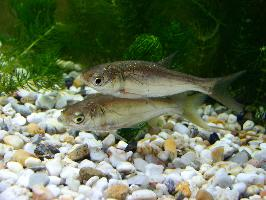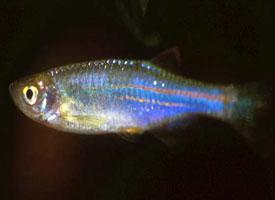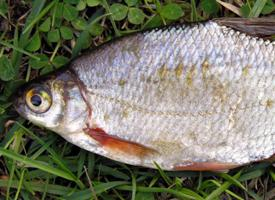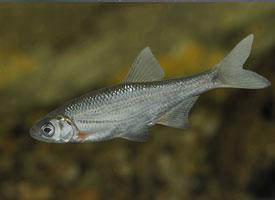
Greutăți și măsuri
| Lungime | 110 cm |
|---|---|
| Greutate | 25 kg |
Date biologice
| Durata de viață | 20 r |
|---|
Descrierea animalului
The Silver carp (Hypophthalmichthys molitrix) is a species of freshwater cyprinid fish that is native to eastern Asia, specifically in countries such as China and Russia. This species is of significant interest both ecologically and economically. It is known for its distinctive appearance and behavior, as well as its rapid growth and high reproductive capacity, which have contributed to its success as an invasive species in various parts of the world, particularly in the United States.Physical Description
Adult Silver carp are large, with some individuals reaching up to 100 cm (39 inches) in length and weighing as much as 20 kg (44 lbs), although sizes of around 60 cm (24 inches) and weights of 2-3 kg (4.4-6.6 lbs) are more common. They have a laterally compressed body, which is typical of many species in the carp family, giving them a somewhat slim profile when viewed head-on. Their scales are small and silvery, which is the origin of their common name, and they possess a keel that runs from the anal fin to the throat, devoid of scales.
One of the most distinctive features of the Silver carp is its eyes, which are positioned downward towards the mouth, giving them a somewhat unusual appearance compared to other fish. This feature is an adaptation to their feeding habits, as it aids in their detection of plankton, their primary food source. Their mouth is large and terminal, equipped to efficiently filter feed on phytoplankton and zooplankton from the water.
Behavior and Ecology
Silver carp are highly gregarious and are often found in large schools. They are primarily filter feeders and have a remarkable ability to consume up to three times their body weight in plankton each day. This voracious appetite for plankton can significantly alter the ecosystem of invaded waters, often outcompeting native species for food resources.
A unique and notable behavior of Silver carp is their tendency to leap high out of the water when startled, especially by the sound of boat motors. This behavior can pose a risk to boaters and water-skiers, as collisions with the airborne fish can result in injuries.
Reproduction and Lifespan
Silver carp reach sexual maturity at about 4-5 years of age. Their spawning habits are influenced by water temperature and flow, with spawning occurring in spring and early summer as water temperatures rise above 18°C (64°F). Females can lay hundreds of thousands of eggs in a single spawning event, which are fertilized externally by males. The eggs are pelagic, drifting downstream until they hatch, which allows for rapid dispersal of the species.
Their lifespan can vary depending on environmental conditions, but individuals living up to 10 years are not uncommon, with some reports suggesting they can live up to 20 years in optimal conditions.
Invasive Species
Originally introduced outside its native range for aquaculture and to improve water quality in treatment facilities, the Silver carp has become an invasive species in many parts of the world, including the United States, where it poses a significant threat to the Great Lakes ecosystem. Their rapid reproduction and growth, combined with a lack of natural predators in these new environments, have allowed Silver carp populations to explode, outcompeting native fish species for food and habitat.
Efforts to control the spread of Silver carp include physical barriers, public awareness campaigns, and research into biological control methods. However, their established presence in large river systems makes eradication difficult.
Conclusion
The Silver carp is a fascinating species with a unique set of characteristics that have allowed it to thrive in various environments. However, its success as an invasive species highlights the need for careful management of non-native species introductions and a better understanding of ecological impacts. As efforts continue to mitigate the spread and impact of Silver carp, this fish remains a topic of significant interest among scientists, environmentalists, and policymakers alike.
Animale similare
Fotografii noi cu animale
Top 10 animale
- Dolphin gull (Leucophaeus scoresbii)
- Diana monkey (Cercopithecus diana)
- Moustached guenon (Cercopithecus cephus)
- Greek tortoise (Testudo graeca)
- Stone loach (Barbatula barbatula)
- Galápagos tortoise (Geochelone nigra complex)
- Japanese macaque (Macaca fuscata)
- Russian tortoise (Testudo horsfieldii)
- Common flying dragon (Draco volans)
- Galápagos penguin (Spheniscus mendiculus)


